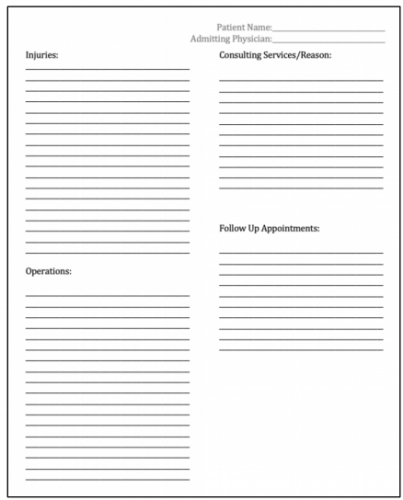I love challenging dogma. I spoke last week (virtually) at an excellent event at the Intermountain Medical Center in Utah. One of my talks there addressed trauma myths and dogma.
I bring this up because there is an interesting article in the Journal of Trauma this month that questions the necessity of the routine chest x-ray (CXR) in blunt trauma resuscitation. So of course, this caught my eye. Let’s dig in.
The first thing to understand is that this article is an opinion piece and is identified as such. It was written by three surgeons, including the trauma medical director, at the Stanford University Hospital trauma center.
First, what are we really looking for on the chest x-ray that is taken in the trauma bay? I call them “the three big things”.
- Big air. The first item to be identified is a pneumothorax. The chest x-ray helps the trauma professionals decide if the pneumo needs an intervention (chest tube) and when. (Note: it could in theory identify a tension pneumothorax. But in that case, the trauma pros should be embarrassed. They should have picked that up on their clinical exam and assessment of the vitals.)
- Big blood. The chest x-ray can also identify a hemothorax. And once again, it can help decide whether its size warrants chest tube insertion.
- Big mediastinum. A wide mediastinum may indicate the presence of hematoma from an aortic injury. It is one of the indications for performing CT angiography of the chest to rule it out.
Here are their authors’ arguments:
- There are other imaging modalities available to us that are very accurate. FAST ultrasound has been used routinely for abdominal and cardiac evaluation for over a decade. The extended FAST (eFAST) involves evaluation of the pleural interface to identify pneumothorax. A study published last year pitted CXR vs eFAST. It found that the eFAST outperformed with a sensitivity of 94% and specificity of nearly 100%.
But what about hemothorax? Ultrasound is less helpful here. But the CT scanner is. It is far more accurate at identifying and quantifying hemothorax than the CXR. - Evaluation of the aorta can either wait, or it can’t wait at all. If the patient loses vital signs in the trauma bay the decision to open the chest or insert a REBOA catheter must be made. In the latter case, a chest x-ray must be obtained to exclude a thoracic source of bleeding that the cathether is of no use for. But if the patient truly is bleeding out from a blunt aortic injury, it is nearly certain that he or she is not leaving the trauma bay alive.
What about using the wide mediastinum as an indication or order the chest CT angiogram? The authors argue that there will probably be a history of deceleration or other associated injuries (femur fracture is a very common one).
Bottom line: The authors argue that the chest x-ray should go the way of the lateral cervical spine x-ray used at the turn of the 21st century and before. They claim that judicious use of the extended FAST and CT angiography can identify the significant injuries we need to know about in a timely manner.
My own opinion is more nuanced. I buy their arguments that the extended FAST will identify all significant pneumothoraces. However, we have typically answered the question “how big is too big” using the chest x-ray. That is the most helpful tool in deciding whether a chest tube is warranted or not.
As for hemothorax, I don’t believe that a CT is the best tool for evaluating this, either. Are the authors members of the “pan-scan” school? What about those of us that use the “selective scan” philosophy. True, the abdominal scan will identify both hemothorax and pneumthorax on the lower cuts of the chest. But as in the previous paragraph, we are better trained to judge when a chest tube is indicated by the appearance of the chest x-ray. Hemothorax (or pneumothorax) is not an indication to get a chest CT.
I don’t buy argument that there will be other indications of potential aortic injury. Deceleration is in the eye of the beholder. How do we know how fast the vehicle was actually moving? What is the magic velocity that will break this patient’s aorta? This particular patient may not have any of the other potential indicators that increase suspicion for aortic injury. That wide mediastinum may be the only clue. Yes, the numbers of affected patients are small, but the consequences of missing one could be deadly.
And what about patients who might not get scanned at all? And those who need a study to confirm tube or line placement? They must absolutely get a chest x-ray before they leave the trauma bay.
At this point, I can’t see a way to dispense with the chest x-ray completely. It should still be used to:
- Confirm pneumothorax from eFAST to help decide if a chest tube is needed
- Identify potential pathology (hemothorax, wide mediastinum) in patients who don’t otherwise meet criteria for chest CT
- Verify endotracheal tube position after intubation
What do you think? Please leave your comments or Tweets about this topic.
References:
- Extended-FAST plus MDCT in pneumothorax diagnosis of major trauma: time to revisit ATLS imaging approach? J Ultrasound. 2019;22(4):461–469.
- Necessity of routine chest radiograph in blunt trauma resuscitation: Time to evaluate dogma with evidence. J Trauma 2020;89(3):e69-70.

